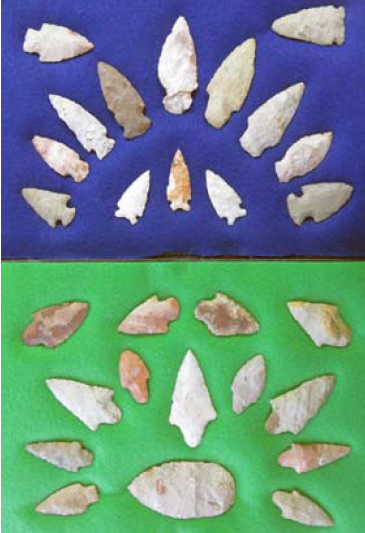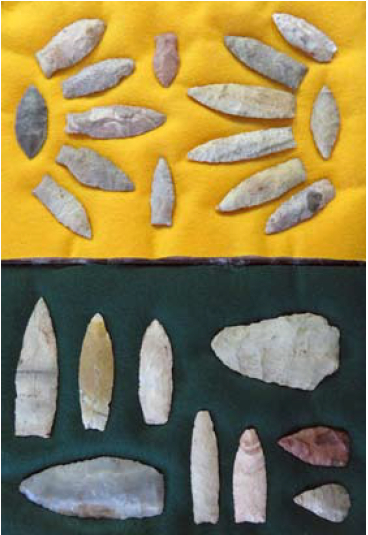|
A Tama County Iowa Collection Rediscovered
|
by David Marolf |
| Central States Archaeological Societies 2020
October Journal |
Manchester, Iowa |
| |
|
|
This excerpt from "A Tama County Iowa
Collection Rediscovered" published in the 2020 Central States Archaeological
Societies 2020 October Journal
Read the complete column in the Central States
Archaeological Societies 2020
October Journal which can be purchased on-line after March 2021
|
|
|
Figures 1 and 2. The pipe is 3 3/16” long
by 1 ½” wide and is 2” in height. It was found near
Davenport, Iowa. Photos courtesy of Terry McGuire and published with permission of the Gilcrease
Museum, Tulsa, Oklahoma. The museum accession number is 6124.1144.
|
Until now, I have written a number of articles in CSAJ pertaining to personal
discoveries made by myself and other members of my family. That is what I
prefer to write about. I have not purchased artifacts for many years since
being educated at a young age at the cost of several hundred dollars to the
dangers of such endeavors. Hopefully, in the future I will be able to write
an article that may help others avoid the same mistake I made. However, this
is an account of a recent purchase I DID make with the details of establishing
the provenance which is crucial to any artifact. I hope you enjoy the story
and learn a little about Iowa’s great artifacts and even greater people.
A number of years ago my friend Steve’s wife passed away at about
the same time as his neighbor Norma’s husband died. The two couples
had always been very close friends so I suppose it was natural that the two
remaining spouses shortly began seeing each other on a regular basis. They
each remain in their own homes, help each other maintain them and go places
together constantly. They have developed a wonderful relationship in the
face of tragic circumstances.
Not long after this, Steve, knowing I was an artifact collector, told me
that Norma had some boxes of arrowheads and other “stuff,” as
he put it, and I should stop in to take a look. It didn’t take long
for me to line up a time that my hunting pal Hank and I could meet with Norma.
We were astonished at what appeared before us. She brought out several boxes
of artifacts and explained that they had been her husband’s, but he
was not the collector. The collection had been passed down to him from ancestors
who settled and farmed in Tama County. For those unfamiliar, Tama County
is near the center of the state, just north of the Iowa River. The assemblage
of over 400 total pieces included many many of the common point types encompassing
the multi-cultural time span from the Late Paleolithic to Mississippian periods,
as well as knives, drills, axes, celts, etc. (Figs. 1-12). Of course, like
novice collectors, all of the pieces were haphazardly jumbled into the boxes,
clanking against each other. We told Norma that damage could occur and to
get us a roll of TP so as Hank and I meticulously scrutinized each piece
we would wrap the better ones individually. They were obviously THE REAL
DEAL, as authentic as a baby’s first tooth! All of them, even the axes,
still had the original Tama County soil (hard, dark yellowish clay) from
which they had been plucked, still caked into their flake scars and orifices;
some so much so that it was difficult to identify the type or culture of
origin.

|
 |
Figure 2. Green frame: Gary and Adena
points including: Dickson, Robins and Waubesa and 3 ¾ “ knife blade. Blue frame: Lg. Arc includes: Atalissa, Snyders and Adena points, on left, 3 Early Archaic Culture Turin atlatl darts and lower right a Matanzas. The largest point measures 2 ¾” in length.
|
Figure 3. Green frame: Upper right 3 points from top to
bottom: Sedalia, Agate Basin and Nebo Hill. Upper left: 4 ½ " Archaic knife. Yellow frame: Top array: 3 Woodland Culture stemmed points flanked by 2 Early Archaic points. Bottom array: 6 Nebo Hill and Sedalia points (Can you tell the difference?). Top and bottom: 2 bi-point knives. Largest piece is 3 ½” long. Sedalia
3rd from the right on bottom arc. The Sedalia is much thinner and wider than the classic Nebo hill to the left of it. |
|
|
|
|
|
Norma was very patient as Hank and I surely explained more than she wanted
to know about her husband’s treasures. After a couple of hours of pure
enjoyment only avid collectors could have, we left knowing the collection
would be well taken care of and safe as long as Norma possessed it. We did
not attempt to purchase the collection, as both of our collections are almost
entirely made of personal finds—the way we like them.
Several years passed and I was about to retire in the Spring of 2014. In
September of 2013 I had purchased a retirement home overlooking Lindsey Creek
a short distance from its confluence with the Maquoketa River, just up-stream
from Manchester, Iowa, and had spent all Fall and Winter prepping it for
the post-retirement move. I had enough artifacts in ....
Read the complete column in the Central States Archaeological Societies 2020
October Journal which can be purchased on-line after March 2021
|
|




